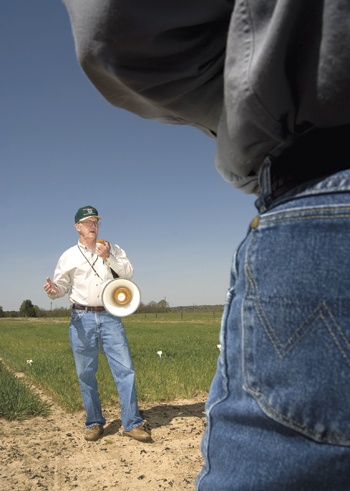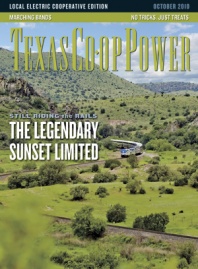The old ways just won’t cut it in a modern beef operation, according to professors at Texas A&M University.
That can be a hard message to swallow for some Texans who yearn to work with cattle. Maybe retirement age is approaching and they remember the way life used to be, before they walked off the family farm to take a job in town. Or maybe they’ve heard a few too many yarns about cattle drives and rodeos, wide-open ranches and cowboys sitting tall in the saddle.
Some folks expect to throw a few heifers onto the home place and watch them pay for themselves. Other people are looking for an agricultural write-off on their tax bill.
For whatever reason, droves of Texans get into the cattle business every year. And for those would-be ranchers, Texas A&M is there to help, offering the Texas AgriLife Pasture and Livestock Management Workshop. The course is held each spring at the Texas AgriLife Research and Extension Center in Overton, east of Tyler.
If the Aggies crush a few romantic notions along the way, well, better to hear it from them first.
“Tradition is the major obstacle of profitability,” says Gerald Evers, a Texas A&M forage management professor, summarizing the message he and other university experts have for cattle operators.
The annual workshop is billed as “grazing school,” but it’s more of a beef boot camp with classroom and corral work. The Aggies cram as much of their research as they can into 2 1/2 days of soil fertility, forage selection, herbicides, cattle nutrition and animal health, stocking rates, genetic selection, financial planning and whatever else they figure a person needs to know before entering the business.
“You’ll gain a whole lot of information toward making the decision whether you want to do it, and if you do, do it the right way,” says professor Greg Clary, extension management economist in Texas A&M’s department of agricultural economics. “You don’t want to have a wreck and lose a bunch of money.”
The workshop’s days are packed with facts, figures and instruction. You have to pay attention to every detail, the university experts warn, or things can go wrong in a hurry. Just ask Shelton Barnes, who attended the workshop last spring.
“I wasted a lot of money on cows because I didn’t manage them right,” says Barnes, 56, who runs 30 head of cattle on land he inherited in Logansport, Louisiana.
A doctor of internal medicine in New Orleans, Barnes said he hopes to retire to his farm in the next five years. The most important advice he gleaned from the workshop, he said, was to plant a rotation of grasses, clovers and winter grains for his cattle to graze at different times throughout the year.
“The biggest expense is hay,” he said. “If I shorten the hay season and lengthen the grazing season, I can make some money. The most important thing you have to do is be a grass farmer first.”
Like Barnes, many of the workshop participants were people who were nearing retirement or who had already retired. Some of them were just looking for something to do with their free time.
“After sitting in an office all my life, it’s nice to get some fresh air and do some hard, physical work,” says Karen Pinkerton, 54, who lives on 12 acres with her husband in Smithville.
At least one thing she hadn’t done is castrate a male calf—a necessary step that turns a bull into a steer, making the livestock more docile and improving their meat quality, according to Jason Cleere, an associate professor and Texas AgriLife Extension beef cattle specialist.
“Castration’s not near as bad as you think it is,” Cleere said. “If you do it on a young animal, it is very easy, low risk.”
To demonstrate, the Aggies ran a calf through a squeeze chute and turned him on his side. One of the professors castrated him, and Cleere dehorned the new steer and vaccinated him, showing participants the best places to insert a needle without damaging any future, prime cuts of meat.
When the professors were done, they turned the steer loose, and he bounded into a holding pen.
Two or three pens down, a mama cow spotted her calf and started bellowing. She and two others were already riled up when Assistant Professor Jason Banta, an Extension beef cattle specialist, climbed into the corral with them for a workshop demonstration on body conditions.
“If one of these is about to run me over, give me a warning,” he said.
The cows didn’t like the distance between them and their calves. In protest, they snorted, bellowed and stamped the ground. They kicked up red dirt that caught the breeze and dusted the crowd that had gathered to watch from the safe side of the corral fence.
With his back to the livestock, Banta explained how ranchers study a cow’s body to judge whether it is in shape for breeding, nursing or other purposes. Suddenly, a cow lowered her head and charged Banta from behind. She had him beat by more than half a ton.
“Look out!” people yelled.
Banta turned around just in time. Like a matador, he sidestepped the angry cow as she lunged past.
“She’s just wanting her baby,” he said. “But thanks for warning me. This is the fifth year, and I haven’t been hit yet.”
——————–
For more information about the Texas AgriLife Pasture and Livestock Management Workshop, visit http://overton.tamu.edu or call (903) 834-6191.
Wes Ferguson is writing a book about the Sabine River.


